With the Night Mail (2)
By:
March 28, 2012
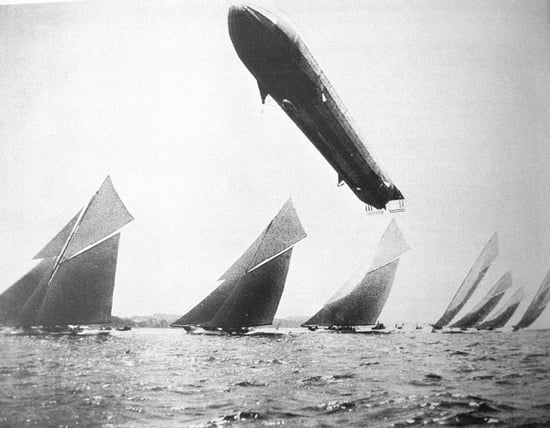
HILOBROW is pleased to present the second installment of our serialization of Rudyard Kipling’s With the Night Mail (and his follow-up story, “As Easy as A.B.C.”). New installments will appear each Wednesday for 12 weeks.
With the Night Mail follows the exploits of an intercontinental mail dirigible battling the perfect storm. Between London and Quebec we learn that a planet-wide Aerial Board of Control (A.B.C.) now enforces a technocratic system of command and control not only in the skies but in world affairs, too. A follow-up story, “As Easy As A.B.C.,” recounts what happens when agitators in Chicago demand a return of democracy: The A.B.C. sends zeppelins armed with sound weapons to subdue not the agitators, but a mob who would destroy them! With the Night Mail is set in 2000, and it first appeared in 1905; 2012 marks the centennial of the first publication of “As Easy As A.B.C.”
In June, HiLoBooks will publish a beautiful new edition of With the Night Mail (and “As Easy as A.B.C.”), checked against the 1909 first published edition (Doubleday), with an Introduction by science fiction author Matthew De Abaitua, and an Afterword by science fiction author Bruce Sterling. SUPPLIES ARE LIMITED! CLICK HERE TO ORDER YOUR COPY.
SUBSCRIBE to HILOBROW’s serialized fiction via RSS.
LAST WEEK: “Our planet’s overlighted if anything,” says Captain Purnall at the wheel, as Cardiff-Bristol slides under. “I remember the old days of common white verticals that ‘ud show two or three thousand feet up in a mist, if you knew where to look for ’em. In really fluffy weather they might as well have been under your hat. One could get lost coming home then, an’ have some fun. Now, it’s like driving down Piccadilly.”
ALL EXCERPTS: 1 | 2 | 3 | 4 | 5 | 6 | 7 | 8 | 9 | 10 | 11 | 12
I have been waiting eagerly for this invitation and I follow Captain Hodgson from the control-platform, stooping low to avoid the bulge of the tanks. We know that Fleury’s gas can lift anything, as the world-famous trials of ’89 showed, but its almost indefinite powers of expansion necessitate vast tank room. Even in this thin air the lift-shunts are busy taking out one-third of its normal lift, and still “162” must be checked by an occasional downdraw of the rudder or our flight would become a climb to the stars. Captain Purnall prefers an overlifted to an underlifted ship; but no two captains trim ship alike. “When I take the bridge,” says Captain Hodgson, “you’ll see me shunt forty per cent. of the lift out of the gas and run her on the upper rudder. With a swoop upwards instead of a swoop downwards, as you say. Either way will do. It’s only habit. Watch our dip-dial! Tim fetches her down once every thirty knots as regularly as breathing.”
So is it shown on the dip-dial. For five or six minutes the arrow creeps from 6,700 to 7,300. There is the faint “szgee” of the rudder, and back slides the arrow to 6,500 on a falling slant of ten or fifteen knots.
“In heavy weather you jockey her with the screws as well,” says Captain Hodgson, and, unclipping the jointed bar which divides the engine-room from the bare deck, he leads me on to the floor.
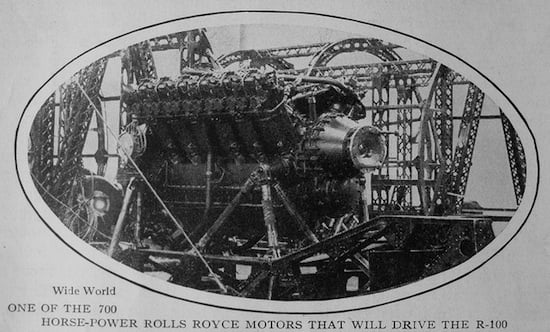
Here we find Fleury’s Paradox of the Bulkheaded Vacuum — which we accept now without thought — literally in full blast. The three engines are H. T. &. T. assisted-vacuo Fleury turbines running from 3,000 to the Limit — that is to say, up to the point when the blades make the air “bell”— cut out a vacuum for themselves precisely as over-driven marine propellers used to do. “162’s” Limit is low on account of the small size of her nine screws, which, though handier than the old colloid Thelussons, “bell” sooner. The midships engine, generally used as a reinforce, is not running; so the port and starboard turbine vacuum-chambers draw direct into the return-mains.
The turbines whistle reflectively. From the low-arched expansion-tanks on either side the valves descend pillarwise to the turbine-chests, and thence the obedient gas whirls through the spirals of blades with a force that would whip the teeth out of a power-saw. Behind, is its own pressure held in leash or spurred on by the lift-shunts; before it, the vacuum where Fleury’s Ray dances in violet-green bands and whirled turbillions of flame. The jointed U-tubes of the vacuum-chamber are pressure-tempered colloid (no glass would endure the strain for an instant) and a junior engineer with tinted spectacles watches the Ray intently. It is the very heart of the machine — a mystery to this day. Even Fleury who begat it and, unlike Magniac, died a multi-millionaire, could not explain how the restless little imp shuddering in the U-tube can, in the fractional fraction of a second, strike the furious blast of gas into a chill grayish-green liquid that drains (you can hear it trickle) from the far end of the vacuum through the eduction-pipes and the mains back to the bilges. Here it returns to its gaseous, one had almost written sagacious, state and climbs to work afresh. Bilge-tank, upper tank, dorsal-tank, expansion-chamber, vacuum, main-return (as a liquid), and bilge-tank once more is the ordained cycle. Fleury’s Ray sees to that; and the engineer with the tinted spectacles sees to Fleury’s Ray. If a speck of oil, if even the natural grease of the human finger touch the hooded terminals Fleury’s Ray will wink and disappear and must be laboriously built up again. This means half a day’s work for all hands and an expense of one hundred and seventy-odd pounds to the G. P. O. for radium-salts and such trifles.
“Now look at our thrust-collars. You won’t find much German compo there. Full-jewelled, you see,” says Captain Hodgson as the engineer shunts open the top of a cap. Our shaft-bearings are C. M. C. (Commercial Minerals Company) stones, ground with as much care as the lens of a telescope. They cost £37 apiece. So far we have not arrived at their term of life. These bearings came from “No. 97,” which took them over from the old “Dominion of Light,” which had them out of the wreck of the “Perseus” aëroplane in the years when men still flew linen kites over thorium engines!
They are a shining reproof to all low-grade German “ruby” enamels, so-called “boort” facings, and the dangerous and unsatisfactory alumina compounds which please dividend-hunting owners and turn skippers crazy.
The rudder-gear and the gas lift-shunt, seated side by side under the engine-room dials, are the only machines in visible motion. The former sighs from time to time as the oil plunger rises and falls half an inch. The latter, cased and guarded like the U-tube aft, exhibits another Fleury Ray, but inverted and more green than violet. Its function is to shunt the lift out of the gas, and this it will do without watching. That is all! A tiny pump-rod wheezing and whining to itself beside a sputtering green lamp. A hundred and fifty feet aft down the flat-topped tunnel of the tanks a violet light, restless and irresolute. Between the two, three white-painted turbine-trunks, like eel-baskets laid on their side, accentuate the empty perspectives. You can hear the trickle of the liquefied gas flowing from the vacuum into the bilge-tanks and the soft gluck-glock of gas-locks closing as Captain Purnall brings “162” down by the head. The hum of the turbines and the boom of the air on our skin is no more than a cotton-wool wrapping to the universal stillness. And we are running an eighteen-second mile.
I peer from the fore end of the engine-room over the hatch-coamings into the coach. The mail-clerks are sorting the Winnipeg, Calgary, and Medicine Hat bags: but there is a pack of cards ready on the table.
Suddenly a bell thrills; the engineers run to the turbine-valves and stand by; but the spectacled slave of the Ray in the U-tube never lifts his head. He must watch where he is. We are hard-braked and going astern; there is language from the control-platform.
“Tim’s sparking badly about something,” says the unruffled Captain Hodgson. “Let’s look.”
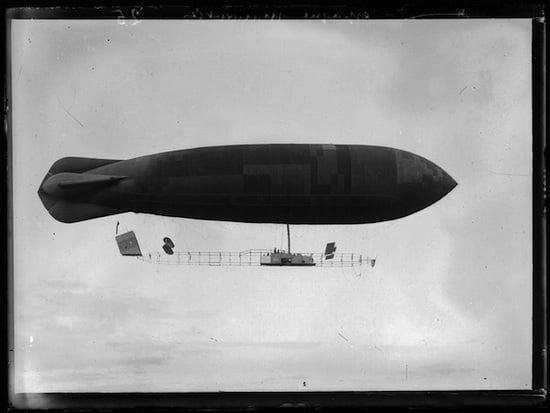
Captain Purnall is not the suave man we left half an hour since, but the embodied authority of the G. P. O. Ahead of us floats an ancient, aluminum-patched, twin-screw tramp of the dingiest, with no more right to the 5,000 foot lane than has a horse-cart to a modern town. She carries an obsolete “barbette” conning-tower — a six-foot affair with railed platform forward — and our warning beam plays on the top of it as a policeman’s lantern flashes on the area sneak. Like a sneak-thief, too, emerges a shock-headed navigator in his shirt-sleeves. Captain Purnall wrenches open the colloid to talk with him man to man. There are times when Science does not satisfy.
“What under the stars are you doing here, you sky-scraping chimney-sweep?” he shouts as we two drift side by side. “Do you know this is a Mail-lane? You call yourself a sailor, sir? You ain’t fit to peddle toy balloons to an Esquimaux. Your name and number! Report and get down, and be ——!”
“I’ve been blown up once,” the shock-headed man cries, hoarsely, as a dog barking. “I don’t care two flips of a contact for anything you can do, Postey.”
“Don’t you, sir? But I’ll make you care. I’ll have you towed stern first to Disko and broke up. You can’t recover insurance if you’re broke for obstruction. Do you understand that?”
Then the stranger bellows: “Look at my propellers! There’s been a wulli-wa down under that has knocked us into umbrella-frames! We’ve been blown up about forty thousand feet! We’re all one conjuror’s watch inside! My mate’s arm’s broke; my engineer’s head’s cut open; my Ray went out when the engines smashed; and … and … for pity’s sake give me my height, Captain! We doubt we’re dropping.”
“Six thousand eight hundred. Can you hold it?” Captain Purnall overlooks all insults, and leans half out of the colloid, staring and snuffing. The stranger leaks pungently.
“We ought to blow into St. John’s with luck. We’re trying to plug the fore-tank now, but she’s simply whistling it away,” her captain wails.
“She’s sinking like a log,” says Captain Purnall in an undertone. “Call up the Banks Mark Boat, George.” Our dip-dial shows that we, keeping abreast the tramp, have dropped five hundred feet the last few minutes.
Captain Purnall presses a switch and our signal beam begins to swing through the night, twizzling spokes of light across infinity.
“That’ll fetch something,” he says, while Captain Hodgson watches the General Communicator. He has called up the North Banks Mark Boat, a few hundred miles west, and is reporting the case.
“I’ll stand by you,” Captain Purnall roars to the lone figure on the conning-tower.
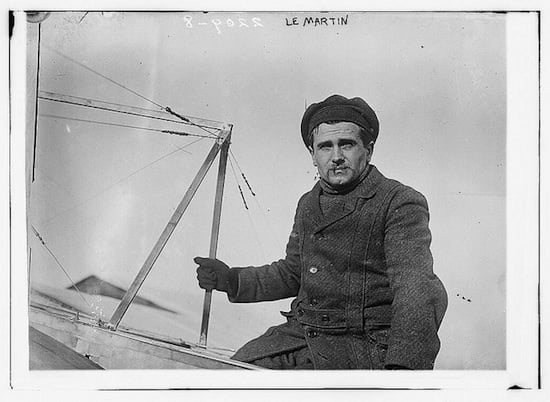
“Is it as bad as that?” comes the answer. “She isn’t insured, she’s mine.”
“Might have guessed as much,” mutters Hodgson. “Owner’s risk is the worst risk of all!”
“Can’t I fetch St. John’s — not even with this breeze?” the voice quavers.
“Stand by to abandon ship. Haven’t you any lift in you, fore or aft?”
“Nothing but the midship tanks and they’re none too tight. You see, my Ray gave out and —” he coughs in the reek of the escaping gas.
“You poor devil!” This does not reach our friend. “What does the Mark Boat say, George?”
“Wants to know if there’s any danger to traffic. Says she’s in a bit of weather herself and can’t quit station. I’ve turned in a General Call, so even if they don’t see our beam some one’s bound to help — or else we must. Shall I clear our slings. Hold on! Here we are! A Planet liner, too! She’ll be up in a tick!”
“Tell her to have her slings ready,” cries his brother captain. “There won’t be much time to spare…. Tie up your mate,” he roars to the tramp.
“My mate’s all right. It’s my engineer. He’s gone crazy.”
“Shunt the lift out of him with a spanner. Hurry!”
“But I can make St. John’s if you’ll stand by.”
“You’ll make the deep, wet Atlantic in twenty minutes. You’re less than fifty-eight hundred now. Get your papers.”
A Planet liner, east bound, heaves up in a superb spiral and takes the air of us humming. Her underbody colloid is open and her transporter-slings hang down like tentacles. We shut off our beam as she adjusts herself — steering to a hair — over the tramp’s conning-tower. The mate comes up, his arm strapped to his side, and stumbles into the cradle. A man with a ghastly scarlet head follows, shouting that he must go back and build up his Ray. The mate assures him that he will find a nice new Ray all ready in the liner’s engine-room. The bandaged head goes up wagging excitedly. A youth and a woman follow. The liner cheers hollowly above us, and we see the passengers’ faces at the saloon colloid.
“That’s a good girl. What’s the fool waiting for now?” says Captain Purnall.
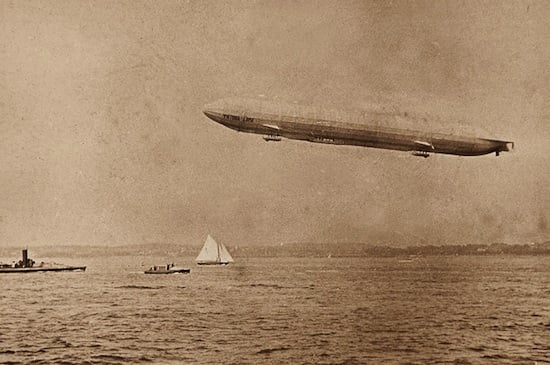
The skipper comes up, still appealing to us to stand by and see him fetch St. John’s. He dives below and returns — at which we little human beings in the void cheer louder than ever — with the ship’s kitten. Up fly the liner’s hissing slings; her underbody crashes home and she hurtles away again. The dial shows less than 3,000 feet.
The Mark Boat signals we must attend to the derelict, now whistling her death song, as she falls beneath us in long sick zigzags.
“Keep our beam on her and send out a General Warning,” says Captain Purnall, following her down.
There is no need. Not a liner in air but knows the meaning of that vertical beam and gives us and our quarry a wide berth.
“But she’ll drown in the water, won’t she?” I ask.
“Not always,” is his answer. “I’ve known a derelict up-end and sift her engines out of herself and flicker round the Lower Lanes for three weeks on her forward tanks only. We’ll run no risks. Pith her, George, and look sharp. There’s weather ahead.”
NEXT WEEK: “We were dragged hither and yon by warm or frozen suctions, belched up on the tops of wulli-was, spun down by vortices and clubbed aside by laterals under a dizzying rush of stars in the company of a drunken moon.”
RADIUM AGE SCIENCE FICTION: “Radium Age” is HILOBROW’s name for the 1904–33 era, which saw the discovery of radioactivity, the revelation that matter itself is constantly in movement — a fitting metaphor for the first decades of the 20th century, during which old scientific, religious, political, and social certainties were shattered. This era also saw the publication of genre-shattering writing by Edgar Rice Burroughs, Sax Rohmer, E.E. “Doc” Smith, Jack London, Arthur Conan Doyle, Aldous Huxley, Olaf Stapledon, Karel Čapek, H.P. Lovecraft, Charlotte Perkins Gilman, Yevgeny Zamyatin, Philip Gordon Wylie, and other pioneers of post-Verne/Wells, pre-Golden Age “science fiction.” More info here.
HILOBOOKS: The mission of HiLoBooks is to serialize novels on HiLobrow; and also, as of 2012, operating as an imprint of Richard Nash’s Cursor, to reissue Radium Age science fiction in beautiful new print editions. So far, we have published Jack London’s The Scarlet Plague, Rudyard Kipling’s With the Night Mail (and “As Easy as A.B.C.”), Arthur Conan Doyle’s The Poison Belt, H. Rider Haggard’s When the World Shook, Edward Shanks’s The People of the Ruins, William Hope Hodgson’s The Night Land, and J.D. Beresford’s Goslings. Forthcoming: E.V. Odle’s The Clockwork Man, Cicely Hamilton’s Theodore Savage, and Muriel Jaeger’s The Man with Six Senses. For more information, visit the HiLoBooks homepage.
READ: You are reading Rudyard Kipling’s With the Night Mail and “As Easy As A.B.C.” Also read our serialization of: Jack London’s The Scarlet Plague | H. Rider Haggard’s When The World Shook
ORIGINAL FICTION: HILOBROW has serialized three novels: James Parker’s The Ballad of Cocky The Fox (“a proof-of-concept that serialization can work on the Internet” — The Atlantic) and Karinne Keithley Syers’s Linda Linda Linda. We also publish original stories and comics.
